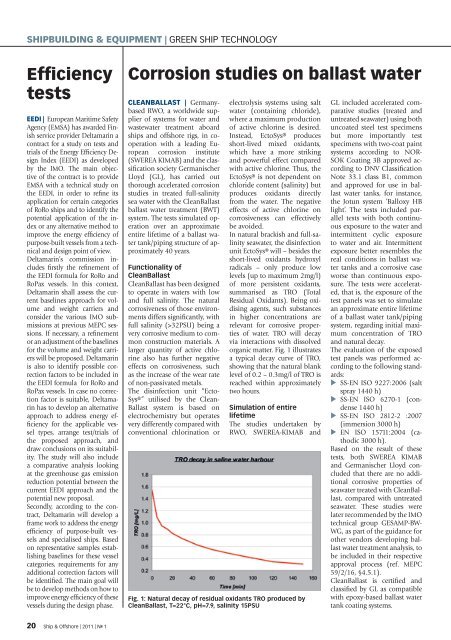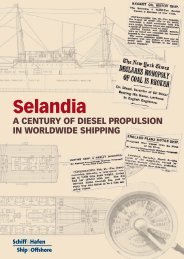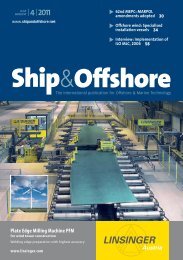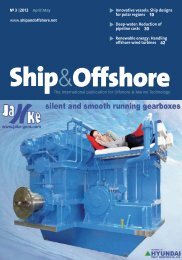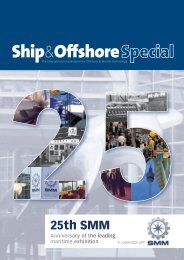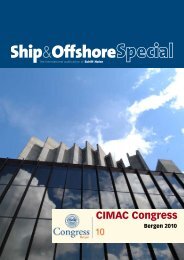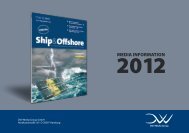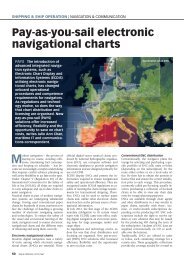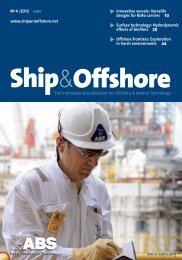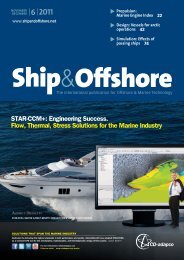Arctic technology: Winterisation of FPSO 38 Cruise ... - Ship & Offshore
Arctic technology: Winterisation of FPSO 38 Cruise ... - Ship & Offshore
Arctic technology: Winterisation of FPSO 38 Cruise ... - Ship & Offshore
You also want an ePaper? Increase the reach of your titles
YUMPU automatically turns print PDFs into web optimized ePapers that Google loves.
SHIPBUILDING & EQUIPMENT | GREEN SHIP TECHNOLOGY<br />
Effi ciency<br />
tests<br />
EEDI | European Maritime Safety<br />
Agency (EMSA) has awarded Finish<br />
service provider Deltamarin a<br />
contract for a study on tests and<br />
trials <strong>of</strong> the Energy Effi ciency Design<br />
Index (EEDI) as developed<br />
by the IMO. The main objective<br />
<strong>of</strong> the contract is to provide<br />
EMSA with a technical study on<br />
the EEDI, in order to refi ne its<br />
application for certain categories<br />
<strong>of</strong> RoRo ships and to identify the<br />
potential application <strong>of</strong> the index<br />
or any alternative method to<br />
improve the energy effi ciency <strong>of</strong><br />
purpose-built vessels from a technical<br />
and design point <strong>of</strong> view.<br />
Deltamarin’s commission includes<br />
fi rstly the refi nement <strong>of</strong><br />
the EEDI formula for RoRo and<br />
RoPax vessels. In this context,<br />
Deltamarin shall assess the current<br />
baselines approach for volume<br />
and weight carriers and<br />
consider the various IMO submissions<br />
at previous MEPC sessions.<br />
If necessary, a refi nement<br />
or an adjustment <strong>of</strong> the baselines<br />
for the volume and weight carriers<br />
will be proposed. Deltamarin<br />
is also to identify possible correction<br />
factors to be included in<br />
the EEDI formula for RoRo and<br />
RoPax vessels. In case no correction<br />
factor is suitable, Deltamarin<br />
has to develop an alternative<br />
approach to address energy effi<br />
ciency for the applicable vessel<br />
types, arrange test/trials <strong>of</strong><br />
the proposed approach, and<br />
draw conclusions on its suitability.<br />
The study will also include<br />
a comparative analysis looking<br />
at the greenhouse gas emission<br />
reduction potential between the<br />
current EEDI approach and the<br />
potential new proposal.<br />
Secondly, according to the contract,<br />
Deltamarin will develop a<br />
frame work to address the energy<br />
effi ciency <strong>of</strong> purpose-built vessels<br />
and specialised ships. Based<br />
on representative samples establishing<br />
baselines for these vessel<br />
categories, requirements for any<br />
additional correction factors will<br />
be identifi ed. The main goal will<br />
be to develop methods on how to<br />
improve energy effi ciency <strong>of</strong> these<br />
vessels during the design phase.<br />
20 <strong>Ship</strong> & <strong>Offshore</strong> | 2011 | N o 1<br />
Corrosion studies on ballast water<br />
CLEANBALLAST | Germanybased<br />
RWO, a worldwide supplier<br />
<strong>of</strong> systems for water and<br />
wastewater treatment aboard<br />
ships and <strong>of</strong>fshore rigs, in cooperation<br />
with a leading European<br />
corrosion institute<br />
(SWEREA KIMAB) and the classifi<br />
cation society Germanischer<br />
Lloyd (GL), has carried out<br />
thorough accelerated corrosion<br />
studies in treated full-salinity<br />
sea water with the CleanBallast<br />
ballast water treatment (BWT)<br />
system. The tests simulated operation<br />
over an approximate<br />
entire lifetime <strong>of</strong> a ballast water<br />
tank/piping structure <strong>of</strong> approximately<br />
40 years.<br />
Functionality <strong>of</strong><br />
CleanBallast<br />
CleanBallast has been designed<br />
to operate in waters with low<br />
and full salinity. The natural<br />
corrosiveness <strong>of</strong> those environments<br />
differs signifi cantly, with<br />
full salinity (>32PSU) being a<br />
very corrosive medium to common<br />
construction materials. A<br />
larger quantity <strong>of</strong> active chlorine<br />
also has further negative<br />
effects on corrosiveness, such<br />
as the increase <strong>of</strong> the wear rate<br />
<strong>of</strong> non-passivated metals.<br />
The disinfection unit “Ecto-<br />
Sys®” utilised by the Clean-<br />
Ballast system is based on<br />
electrochemistry but operates<br />
very differently compared with<br />
conventional chlorination or<br />
electrolysis systems using salt<br />
water (containing chloride),<br />
where a maximum production<br />
<strong>of</strong> active chlorine is desired.<br />
Instead, EctoSys® produces<br />
short-lived mixed oxidants,<br />
which have a more striking<br />
and powerful effect compared<br />
with active chlorine. Thus, the<br />
EctoSys® is not dependent on<br />
chloride content (salinity) but<br />
produces oxidants directly<br />
from the water. The negative<br />
effects <strong>of</strong> active chlorine on<br />
corrosiveness can effectively<br />
be avoided.<br />
In natural brackish and full-salinity<br />
seawater, the disinfection<br />
unit EctoSys® will – besides the<br />
short-lived oxidants hydroxyl<br />
radicals – only produce low<br />
levels (up to maximum 2mg/l)<br />
<strong>of</strong> more persistent oxidants,<br />
summarised as TRO (Total<br />
Residual Oxidants). Being oxidising<br />
agents, such substances<br />
in higher concentrations are<br />
relevant for corrosive properties<br />
<strong>of</strong> water. TRO will decay<br />
via interactions with dissolved<br />
organic matter. Fig. 1 illustrates<br />
a typical decay curve <strong>of</strong> TRO,<br />
showing that the natural blank<br />
level <strong>of</strong> 0.2 – 0.3mg/l <strong>of</strong> TRO is<br />
reached within approximately<br />
two hours.<br />
Simulation <strong>of</strong> entire<br />
lifetime<br />
The studies undertaken by<br />
RWO, SWEREA-KIMAB and<br />
Fig. 1: Natural decay <strong>of</strong> residual oxidants TRO produced by<br />
CleanBallast, T=22°C, pH=7.9, salinity 15PSU<br />
GL included accelerated comparative<br />
studies (treated and<br />
untreated seawater) using both<br />
uncoated steel test specimens<br />
but more importantly test<br />
specimens with two-coat paint<br />
systems according to NOR-<br />
SOK Coating 3B approved according<br />
to DNV Classifi cation<br />
Note 33.1 class B1, common<br />
and approved for use in ballast<br />
water tanks, for instance,<br />
the Jotun system ‘Balloxy HB<br />
light’. The tests included parallel<br />
tests with both continuous<br />
exposure to the water and<br />
intermittent cyclic exposure<br />
to water and air. Intermittent<br />
exposure better resembles the<br />
real conditions in ballast water<br />
tanks and a corrosive case<br />
worse than continuous exposure.<br />
The tests were accelerated,<br />
that is, the exposure <strong>of</strong> the<br />
test panels was set to simulate<br />
an approximate entire lifetime<br />
<strong>of</strong> a ballast water tank/piping<br />
system, regarding initial maximum<br />
concentration <strong>of</strong> TRO<br />
and natural decay.<br />
The evaluation <strong>of</strong> the exposed<br />
test panels was performed according<br />
to the following standards:<br />
� SS-EN ISO 9227:2006 (salt<br />
spray 1440 h)<br />
� SS-EN ISO 6270-1 (condense<br />
1440 h)<br />
� SS-EN ISO 2812-2 :2007<br />
(immersion 3000 h)<br />
�<br />
EN ISO 15711:2004 (ca-<br />
thodic 3000 h).<br />
Based on the result <strong>of</strong> these<br />
tests, both SWEREA KIMAB<br />
and Germanischer Lloyd concluded<br />
that there are no additional<br />
corrosive properties <strong>of</strong><br />
seawater treated with CleanBallast,<br />
compared with untreated<br />
seawater. These studies were<br />
later recommended by the IMO<br />
technical group GESAMP-BW-<br />
WG, as part <strong>of</strong> the guidance for<br />
other vendors developing ballast<br />
water treatment analysis, to<br />
be included in their respective<br />
approval process (ref. MEPC<br />
59/2/16, §4.5.1).<br />
CleanBallast is certifi ed and<br />
classifi ed by GL as compatible<br />
with epoxy-based ballast water<br />
tank coating systems.


